

A secure access company providing solutions for people, devices and systems based on the principles of Zero Trust. Stock chart is not supported by your current browser Gain.Appgate | 43,461 followers on LinkedIn. 10 months ago - Business WireAPGT - Appgate, Inc. (OTC: APGT) (“Appgate” or the “Company”), the secure access company, today announced financial and operational results for the second quarter 2022.
Multimon remote desktop software#
Helping businesses choose better software since 1999 flow io MIAMI- (BUSINESS WIRE)-Appgate, Inc. Check Capterra to compare Frontegg and Appgate SDP based on pricing, features, product details, and verified reviews. Appgate SDP is a cloud-native, unified, API-enabled solution which delivers valuable security, efficiency and user experience benefits. Appgate SDP, an industry-leading Zero Trust Network Access (ZTNA) solution, puts your people first with simple, fast, secure connections to multi-cloud, on-prem, or legacy applications - from anywhere.

If you are using an older supported version of SDP, you can find links to. NOTE: Links to the Appgate SDP Admin Guide and Appgate SDP User Guide are for the most recent supported version of Appgate SDP. | Appgate is the secure access company.The Appgate SDP Client User Guide is provided as contextual help within the client itself, and is also available online (click the link above).

coastal constructors Appgate provides secure access to your network and for your consumers using leading Zero Trust network security and fraud protection solutionsAppgate | 43,494 followers on LinkedIn. View APGT historial stock data and compare to other stocks and exchanges. departments of Defense and Homeland Security, as well as Fifth Third. Appgate, built on a so-called zero-trust foundation and spun out of Cyxtera Technologies, has customers including the U.S.Appgate Home Contact Us Appgate SDP Title Routing Internet Traffic through Appgate SDP Article Number 000001167 Details By default, Appgate SDP performs split tunneling, which allows a user to access dissimilar security domains like a public network (e.g., the internet) and a local LAN or WAN at the same time.


 0 kommentar(er)
0 kommentar(er)
